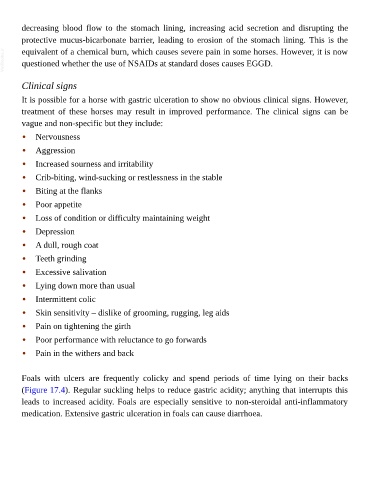Page 750 - The Veterinary Care of the Horse
P. 750
decreasing blood flow to the stomach lining, increasing acid secretion and disrupting the
protective mucus-bicarbonate barrier, leading to erosion of the stomach lining. This is the
VetBooks.ir equivalent of a chemical burn, which causes severe pain in some horses. However, it is now
questioned whether the use of NSAIDs at standard doses causes EGGD.
Clinical signs
It is possible for a horse with gastric ulceration to show no obvious clinical signs. However,
treatment of these horses may result in improved performance. The clinical signs can be
vague and non-specific but they include:
• Nervousness
• Aggression
• Increased sourness and irritability
• Crib-biting, wind-sucking or restlessness in the stable
• Biting at the flanks
• Poor appetite
• Loss of condition or difficulty maintaining weight
• Depression
• A dull, rough coat
• Teeth grinding
• Excessive salivation
• Lying down more than usual
• Intermittent colic
• Skin sensitivity – dislike of grooming, rugging, leg aids
• Pain on tightening the girth
• Poor performance with reluctance to go forwards
• Pain in the withers and back
Foals with ulcers are frequently colicky and spend periods of time lying on their backs
(Figure 17.4). Regular suckling helps to reduce gastric acidity; anything that interrupts this
leads to increased acidity. Foals are especially sensitive to non-steroidal anti-inflammatory
medication. Extensive gastric ulceration in foals can cause diarrhoea.

